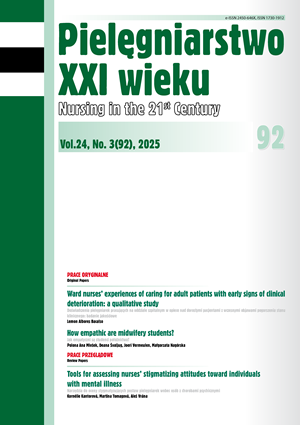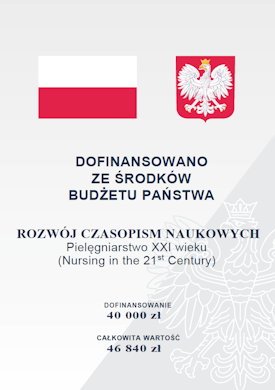Jak empatyczni są studenci położnictwa?
DOI:
https://doi.org/10.12923/pielxxiw-2025-0027Słowa kluczowe:
program nauczania, położnictwo empatyczne, postawa studentów, praca emocjonalnaAbstrakt
JAK EMPATYCZNI SĄ STUDENCI POŁOŻNICTWA?
Cel pracy. Celem opisywanego badania była ocena poziomu empatii wśród studentów położnictwa na wydziałach w Chorwacji, Słowenii, Belgii i Polsce; każde państwo reprezentuje różne regiony Europy, ale jednocześnie wszystkie mają podobieństwa w kształceniu położnych ze względu na dyrektywy UE.
Materiał i metody. Przeprowadzono badanie ilościowe przy użyciu zwalidowanego narzędzia badawczego - Skali Empatii Położnej (MES), która została przetłumaczona w ramach procedury podwójnie ślepej próby dla każdego kraju. Zastosowano celową próbę studentów położnictwa, w tym studentów pierwszego, drugiego i trzeciego roku studiów licencjackich. Komisja etyczna wydziału zatwierdziła projekt badania. Obliczono podstawowe miary opisowe.
Wyniki. Stwierdzeniem, które uzyskało najwyższe wyniki na skali MES było „Wierzę, że empatia odgrywa ważną rolę w opiece położniczej”, podczas gdy najmniej zgodne były stwierdzenia: „Emocje kobiet mnie nie dotyczą, Nie wzruszam się, gdy widzę, że kobieta płacze oraz Bardzo wrażliwe kobiety mnie irytują”. W sumie średnie wartości nie różniły się między studentami położnictwa pierwszego i ostatniego roku, a średni wynik na MES-R wynosił 59.
Wnioski. Nie możemy stwierdzić, że obecny program nauczania w badanych instytucjach sprzyja poziomowi empatii uczniów, jednak pewne różnice wskazują na możliwe elementy kulturowe.
Bibliografia
1. Gaba DM. The future vision of simulation in health care. Qual. Saf. Heal. Care. 2004; 13(1):1-10. https://doi.org/10.1136/qshc.2004.009878
2. Lioce L, et al. Healthcare Simulation Dictionary – Second Edition, Rockville, MD Agency Healthc. Res. Qual. 2020.
3. Kohn LT, Corrigan JM, Donaldson MS. To err is human: building a safer health system. Washington, DC: National Academy Press. 1999.
4. Tomaszewska K, Majchrowicz B, Trojnar P, et al. Medical simulation as a method of practical training in the opinion of nursing students. Nursing in the 21st Century. 2023; 22:85-92. http://doi.org/10.2478/pielxxiw-2023-0016
5. Fisher M, Vishwas A, Cross S,et al. Simulation training for Police and Ambulance Services: improving care for people with mental health needs. BMJ Simul Technol Enhanc Learn. 2020; 6(2):121-122. https://doi.org/10.1136/bmjstel-2018-000423
6. Saber DA, Strout K, Caruso LS, et al. An interprofessional approach to continuing education with mass casualty simulation: planning and execution. J. Contin. Educ. Nurs. 2017;48(10):447-453. https://doi.org/10.3928/00220124-20170918-05
7. World Medical Association. Declaration of Helsinki, Ethical Principles for Scientific Requirements and Research Protocols. World Med. Assoc. 1964. 2024; 29–32. https://ww w.wma.net/policies-post/wma-declaration-of-helsinki-ethical¬principles-for-medical-research-involving-human-subjects/
8. Tong A, Sainsbury P, Braig J. Consolidated criteria for reporting qualitative research (COREQ): A 32-item checklist for interviews and focus groups. Int. J. Qual. Health Care. 2007; 19(6): 349-357. https://doi.org/10.1093/intqhc/mzm042
9. Faria-Schützer DB, Surita FG, Alves VLP, et al. Seven steps for qualitative treatment in health research: the Clinical-Qualitative Content Analysis. Cien. Saude. Colet. 2021; 26(1):265-274. https://doi.org/10.1590/1413-81232020261.07622019
10. Krueger RA, Casey MA. Designing and conducting focus group interviews. Social Analysis Selected Tools and Techniques. 2001;36:4-23.
11. Nestel D, Hui J, Kunkler K, et al. A practical guide healthcare simulation research. Cham: Springer Nature Switzerland AG; 2019.
12. Roche A, Watkins E, Pettit A, et al. Impact of prehospital ultrasound training on simulated paramedic clinical decision-making. West J. Emerg. Med. 2024;25(5):784-792. https://doi.org/10.5811/westjem.18439
13. Husain S, Eisenberg M. Police AED programs: A systematic review and meta-analysis. Resuscitation. 2013;84(9):1184-1191. https://doi.org/10.1016/j.resuscitation.2013.03.040
14. Williams-Bell F, Kapralos B, Hogue A, et al. Using serious games and virtual simulation for training in the fire service: a review. Fire Technol. 2015; 51(3): 553-584. https://doi.org/10.1007/s10694-014-0398-1
15. Guise JM, Hansen M, Lambert W, et al. The role of simulation in mixed-methods research: A framework & application to patient safety. BMC Health Serv. Res. 2017; 17(1):1-7. https://doi.org/10.1186/s12913-017-2255-7
16. State of Victoria. Simulation and Patient Safety: The Benefits for Your Organisation. Melbourne: Department of Health & Human Services; 2015, p. 22.
17. Kardong-Edgren S, Jeffries P. The NCSBN national simulation study: a longitudinal, randomized, controlled study replacing clinical hours with simulation in prelicensure nursing education. J. Nurs. Regul. 2014;5(2):3-40. https://doi.org/10.1016/S2155-8256(15)30062-4
18. Marshall C, Van Der Volgen J, Lombardo N, et al. A mixed methods approach to assess the impact of an interprofessional education medical error simulation. Am. J. Pharm. Educ. 2020;84 (2):217-230. https://doi.org/10.5688/ajpe7133
19. Kumar A, Ameh C. Start here- principles of effective undergraduate training. Best Pract. Res. Clin. Obstet. Gynaecol. 2022;80:114-125. https://doi.org/10.1016/j.bpobgyn.2021.11.010
20. Karunathilake I. The role of simulation in Postgraduate Medical Education. J. Postgrad. Inst. Med. 2018;5(1):67. https://doi.org/10.4038/jpgim.8185
21. Padrez KA, Brown J, Zanoff A, et al. Development of a simulation-based curriculum for Pediatric prehospital skills: a mixed-methods needs assessment. BMC Emerg. Med. 2021;21(1):1-10. https://doi.org/10.1186/s12873-021-00494-4
22. Abelsson A, Lundberg L.Simulation as a means to develop firefighters as emergency care professionals. Int. J. Occup. Saf. Ergon. 2019; 25(4):650-657. https://doi.org/10.1080/10803548.2018.1541122
23. Avery P, Thompson C, Cowburn P. Training the trainers: improving the quality of education delivered to paramedics through a simulation-debrief model. Br. Paramed. J. 2023;7(4):51-56. https://doi.org/10.29045/14784726.2023.3.7.4.51
Pobrania
Opublikowane
Numer
Dział
Licencja
Prawa autorskie (c) 2025 Polona Ana Mivšek, Deana Švaljug, Joeri Vermeulen, Małgorzata Nagórska (Autor)

Utwór dostępny jest na licencji Creative Commons Uznanie autorstwa 4.0 Międzynarodowe.




